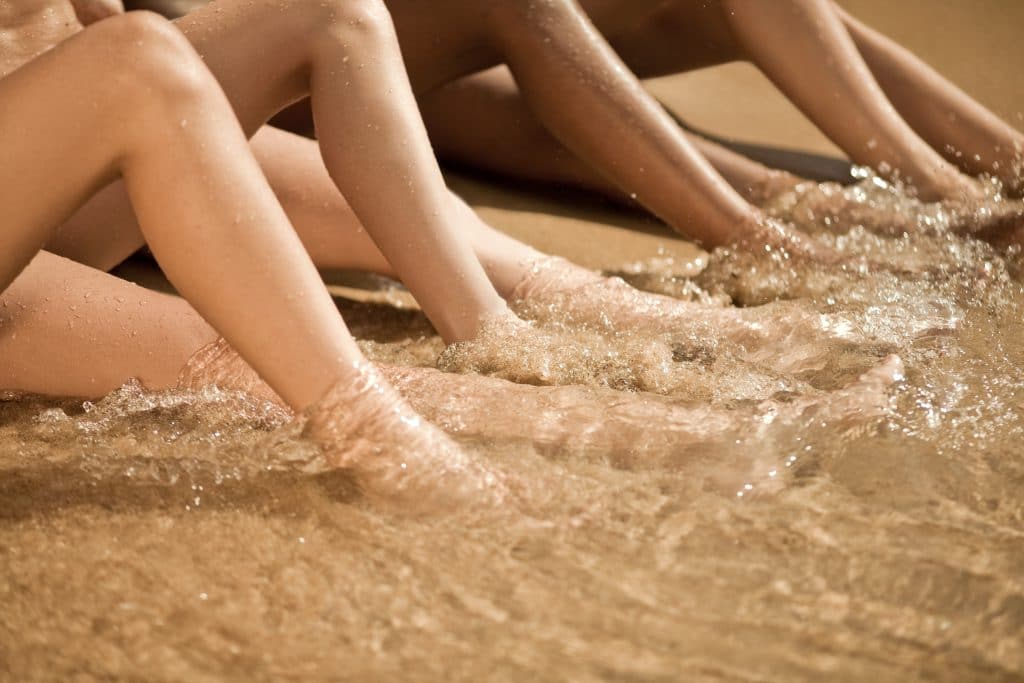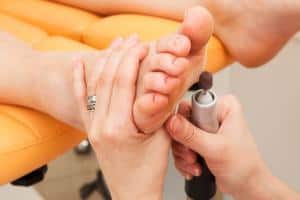
What’s wrong with my feet?
The most commonly encountered skin problems seen by podiatrists.
While a multitude of different skin problems are seen by podiatrists on a daily basis some occur much more often than others. When a rash or other skin irregularity is seen some type of infection is usually the culprit. These can be caused by bacteria, fungi, or even viruses, as in the case of warts. Direct irritation, such as caused by repetitive rubbing or friction, is also quite common, as are allergic reactions. To complicate matters the appearance and symptoms of the above conditions often mimic one another. For this reason, and many others, it’s always best to seek professional care for any skin problems of the feet.
#1—Plantar Warts
Technically known as verruca plantaris, plantar warts are caused by a viral infection. Much as it sounds these are normally found on the bottoms of the feet but are frequently encountered on the sides of the feet as well. Each individual wart, or verruca, usually appears as a raised, circular lesion with a flat top which can contain several small black spots. Even with their distinctive appearance it’s possible to mistake warts for calluses or corns. Warts are unusually resistant to treatment yet several techniques can eradicate them completely when used correctly.
2. Athlete’s foot
An athlete’s foot is a fungal infection that affects the areas between the toes and the bottoms of the feet.
It is caused by a fungus that thrives in warm, dark, moist environments. It can irritate the skin, resulting in a scaly, white rash with a red base.
Itching, burning, peeling, and a mild odor are some of the other symptoms of an athlete’s foot.
Keep your feet and toes clean and dry, change your shoes and socks regularly, and never go barefoot in public locker rooms or showers to reduce your risk of athlete’s foot (also known as tinea pedis).
Athletes’ feet can be treated with over-the-counter antifungal creams or sprays, and sprays and powders can also be used inside your shoes to kill any leftover fungus.
3. Plantar Fasciitis
Plantar fasciitis is a painful condition that affects the bottom of your heel and the lower half of your middle foot.
This occurs when the plantar fascia ligament is strained as a result of wearing soft-soled footwear with poor arch support, standing for long periods of time, long-distance jogging, weight gain, or other foot problems.
It might get worse with time, and the pain can be subtle or intense. When your feet have been resting for a long time, you may feel increased pain.
Applying ice, taking anti-inflammatory drugs, and stretching the foot on a daily basis are all home remedies for the problem. Corticosteroid injections, physical therapy, orthotics, or surgery may be used by your doctor to relieve discomfort.
4. Toenail Fungus
Toenail fungus can make nails look unsightly and distorted. It’s also possible for it to spread to other nails, such as fingernails.
Toenail fungus develops when the nail is damaged, causing the nail-skin junction, where the nail meets the toe’s skin, to be disrupted.
This can happen after a pedicure, as a result of ill-fitting shoes, or as a result of repetitive trauma such as running or hiking, which causes the nail to lift or become forced on.n
5. Corns and Calluses
As with blisters, corns and calluses are the result of repetitive rubbing or pressure. Calluses present as thickened areas of skin over pressure points, and are essentially a protective response to excessive friction. Most people have calluses to some degree and experience no symptoms at all. Only when calluses are unusually thick or become cracked do they typically cause problems. When this occurs the callus can be shaved down to restore more normal skin thickness and provide relief. Calluses commonly form on the heels and balls of the feet.
Corns are also caused by the same protective mechanism. They appear as raised and conical as opposed to broad and flat. They’re typically located on the outside of the pinkie (5th) toe, an area which is particularly prone to friction. Corns tend to be much more painful than calluses, and can be shaved down, treated with topical medications, or both.
How Podiatrists treat foot problems?
Podiatrists are healthcare professionals specializing in the diagnosis, treatment, and prevention of foot and ankle disorders. They employ various treatment approaches to address foot problems, depending on the specific condition and its severity. Here are some common methods used by podiatrists:
- Medications: Podiatrists may prescribe medications such as anti-inflammatory drugs, pain relievers, or antifungal medications to manage pain, inflammation, or infections related to foot problems.
- Orthotic Devices: Podiatrists may recommend or prescribe orthotic devices, such as custom-made shoe inserts or orthopedic footwear, to provide support, improve foot alignment, and alleviate symptoms.
- Physical Therapy: Podiatrists may employ physical therapy techniques, including exercises, stretches, and manual therapy, to improve foot strength, flexibility, and range of motion. Physical therapy can help alleviate pain, improve mobility, and promote healing.
- Footwear Recommendations: Podiatrists provide guidance on appropriate footwear choices based on the specific foot condition. They may recommend shoes with proper support, cushioning, and adequate room for the toes to prevent or alleviate foot problems.
- Surgical Interventions: In cases where conservative treatments do not provide sufficient relief, podiatrists may consider surgical interventions. They can perform various foot surgeries, such as bunionectomy, hammertoe correction, or plantar fascia release, to address structural issues, correct deformities, or alleviate chronic pain.
- Wound Care: Podiatrists specialize in managing foot wounds, particularly in patients with diabetes or circulation problems. They employ advanced wound care techniques, including debridement, dressings, and offloading methods, to promote wound healing and prevent complications.
- Injection Therapies: Podiatrists may utilize injection therapies to alleviate pain and inflammation in certain foot conditions. This may include corticosteroid injections to reduce inflammation and relieve pain in conditions like plantar fasciitis or bursitis. Injections of platelet-rich plasma (PRP) or other regenerative substances may also be used to promote tissue healing and regeneration in certain cases.

